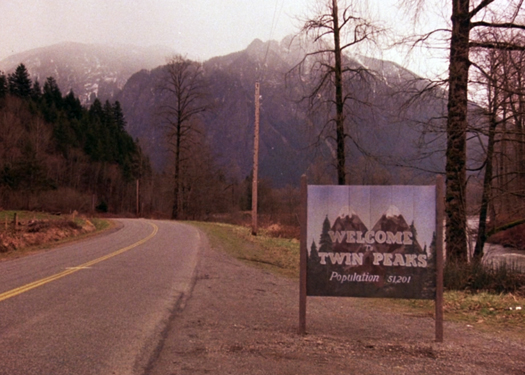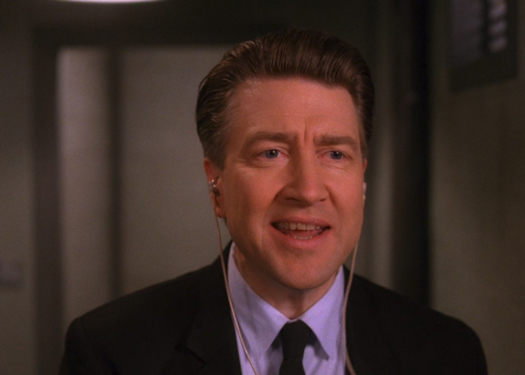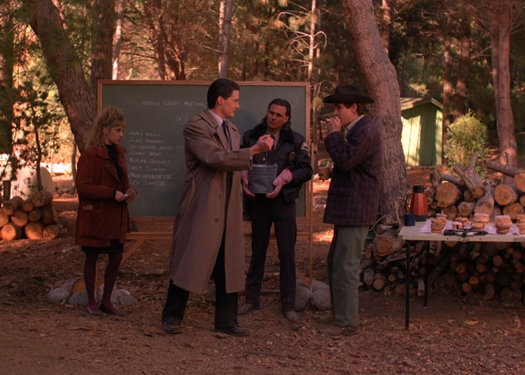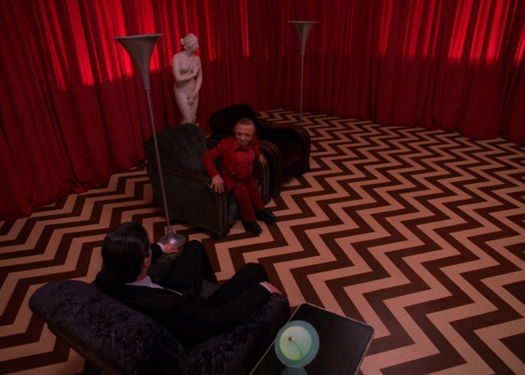TWIN PEAKS: Part 1
Something Wicked This Way Comes

“Who killed Laura Palmer?” The question that echoed from every magazine cover, every water cooler, every sofa, every subway train across the world. A mystery had piqued the interest of the world after the first airing of Twin Peaks. Everyone had a theory, “The killer was James!” or “The killer is Audrey!” In modern television, this kind of speculation is common. Especially on formats like Youtube, Reddit, and forums across the net; everyone has a theory. Everyone wants an answer.
It’s hard to imagine today, but prior to Twin Peaks, concurrent plotlines episode to episode wasn’t prevalent in mainstream TV. The common belief was that people would not want to watch a show that didn’t wrap up its plot by the end of the episode. The likes of Miami Vice had to have its story or plot wrapped up by the end of the forty-five minutes. This was primarily due to people missing episodes or dropping off for a few weeks and coming back again. Wrapping up the plot by the end meant you can watch an episode and feel content that what you saw was started and finished. By the end of an episode of The A-Team, Hannibal and the gang had shot up half a town, nobody got killed, and they were well on their way to another damsel in distress who needed half their small town blown to pieces.
At some point in the eighties, the mystery of who shot J.R. spiked Dallas‘s ratings. The mystery spanned multiple episodes, and the viewership remained setting the foundation for the more lucrative reasons for Twin Peaks.
I can only imagine it was a hard sell for David Lynch, the weirdest director on the planet, wanting to make a tv soap opera? Along with Mark Frost no less, the writer of Hill Street Blues. It’s the  stuff of nightmares. The kind of nightmares of such immense personal pressure. Like the dream one has where you turn up to school and there is an exam you haven’t studied for. But, it is far worse when you’re going to talk to a board of money men in suits asking for 1.1 million per episode. Not to mention it is gonna be co-written and directed by a man whose work has gone from stellar Oscar bait to incomprehensible and he will be accompanied by a screenwriter who has only seen moderate success. That’s real pressure and its no nightmare, it happened and 1.1 million per episode was granted by staunch businessmen taking a huge risk.
stuff of nightmares. The kind of nightmares of such immense personal pressure. Like the dream one has where you turn up to school and there is an exam you haven’t studied for. But, it is far worse when you’re going to talk to a board of money men in suits asking for 1.1 million per episode. Not to mention it is gonna be co-written and directed by a man whose work has gone from stellar Oscar bait to incomprehensible and he will be accompanied by a screenwriter who has only seen moderate success. That’s real pressure and its no nightmare, it happened and 1.1 million per episode was granted by staunch businessmen taking a huge risk.
The dream train was in full swing and something very very special happened. The kind of moment you only see in one lifetime and it wouldn’t happen again for twenty-five years. Twin Peaks’ opening set a standard and almost formulaic set of diegetic rules. The small sleepy town of Twin Peaks near the lake, a beautiful morning, an older yet unnamed gentleman comes across something by the rugged sand. We don’t yet see what it is, but he panics and calls the sheriff. The sheriff and the gentleman investigate his finding, a rolled up plastic sheet with something hard and cold inside. Pulling back the plastic, the beautiful face of the homecoming queen Laura Palmer (Sheryl Lee) appears, cold dead. In some weird way, this was indeed a “birth” for the character as we would learn about her from this blank slate. She would spiral into something else, and as the season dragged out, further parts of Laura’s story prior to her death were revealed. She may not have been the sweet girl everyone knew.
Twin Peaks starred a few Lynch regulars, including Kyle Maclachlan and Jack Nance, along with younger, newer faces. All were weaved into a myriad of characters with strange and particular quirks and habits. And I mean strange. One lady walks around Twin Peaks with a log that she talks to and relays exposition, driving the plot sometimes forward, sometimes askew. Every character was sleeping with someone that they weren’t meant to be sleeping with. Drug problems, domestic abuse, and a conspiracy involving a one-armed man and a dancing midget, there was no shortage of problems in the idyllic small town of Twin Peaks.
The plot was simple. A girl washes up on the shore of a nice little town, the kind of town you wanna retire in. A rather positive and quirky FBI agent by the name of Dale Cooper (Kyle Maclachlan) is sent to Twin Peaks to track down the killer. Seems pretty straightforward and incomplex right? Sure, for about the first episode.
As soon as the first episode is done, a massive web of a narrative is spun. Lynch takes these characters and plays with them in his own “dreamscape”, toying with viewer’s expectation. Agent Cooper follows lead after lead, which seemingly results in nothing.
 Investigating in a peculiar manner such as putting names on a blackboard, mentioning how they are connected to the case, then trying to hit an empty bottle with a thrown rock when each name is spoken, developing a lead only when a rock hits the bottle, it’s almost as if Cooper leaves his investigation to fate. Cooper will dream about the case, take what he saw in his dream as absolute fact, and continue his investigation based on his dream.
Investigating in a peculiar manner such as putting names on a blackboard, mentioning how they are connected to the case, then trying to hit an empty bottle with a thrown rock when each name is spoken, developing a lead only when a rock hits the bottle, it’s almost as if Cooper leaves his investigation to fate. Cooper will dream about the case, take what he saw in his dream as absolute fact, and continue his investigation based on his dream.
During these certain episodes, you can see the hand of Lynch’s craftsmanship. When Cooper dreams, he goes to a stunningly beautiful room surrounded in red curtains (the kind you see in the cinema or theatre) and a black and white floor with a bizarre but symmetrical pattern. This room is synonymous with Twin Peaks and somewhat Lynch himself. It is indeed a beautiful set, but it is so much more than just beauty and cinematic aesthetics. It’s the focal point of the series and ties each story of Twin Peaks together. In the middle of this room lies a chair, Cooper will sit upon the chair and whomever or rather whatever he is communicating with will talk to him in a strange manner (initially the dialogue was delivered backward, recorded, and then played backward). It would be understandable, but with the inflections and curves of the word in the wrong places, the words seem really out of place and uncanny. These scenes are where Lynch stretches out his fingers into the narrative. What I’m sure was a two sentence line in the script (such as “Cooper dreams of Laura saying ‘Fire walk with me.’ He awakens puzzled.”), becomes a long intricate scene that can stretch on and test the patience of the viewer, but also have the moments that made Twin Peaks chilling and unnerving.
Possibly the most famous scene in the lodge includes the brilliant use of the whole Black Lodge roster. As Agent Cooper falls asleep in The Great Northern Hotel one night, his consciousness is visited by the Black Lodge. Lights flash around the mysterious one-armed man, lighting up his eyes and face as he speaks slowly in the unsettling and bizarre tone:
“Through the darkness of future past
the magician longs to see,
one chants out between two worlds,
fire walk with me”
After which, we see Cooper in the lodge. He is older and joined by Laura and a mysterious midget who bullet points further the mysterious nature of the series by saying, “I’ve got good news, the gum you like is coming back in style. She’s my cousin but doesn’t she look just like Laura Palmer?” The midget is gleeful and always happy which furthers the growth of the seed of unsettlement. The Laura Palmer in the lodge then speaks the most chilling line in the series, “I feel like her, but sometimes my arms bend back.” She seems pained by her sentence. Immediately afterward, the midget dances to a music number while Laura kisses the old Cooper.
 You may be either reading this or watching Twin Peaks for the first time and think none of this makes any sense, and yes you would be correct. It doesn’t make any conventional, logical sense. Looking deeper for answers in every sentence, every word, or every metaphorical action can still leave you no better off than when you started, but this is the true magic of Twin Peaks. The unknown, the constant mystery, the paranoia, and the suspicion. Unfortunately, people do indeed want solid answers, so the show was eventually rushed to a conclusion.
You may be either reading this or watching Twin Peaks for the first time and think none of this makes any sense, and yes you would be correct. It doesn’t make any conventional, logical sense. Looking deeper for answers in every sentence, every word, or every metaphorical action can still leave you no better off than when you started, but this is the true magic of Twin Peaks. The unknown, the constant mystery, the paranoia, and the suspicion. Unfortunately, people do indeed want solid answers, so the show was eventually rushed to a conclusion.
I don’t actually think Lynch intended Laura’s death to ever really be resolved. It’s too obvious for him to do a simple whodunit. The town of Twin Peaks was the focus for Lynch. The mysticism of the Black Lodge and what it meant was where Lynch wanted to go. You can feel it in the episodes leading into season two as the pressure to reveal the killer lead to it being revealed midway through the second season and some half-baked continuation of the story developed quickly after. This went nowhere, asking the wrong questions, and including more direct approaches such as aliens, etc. Unfortunately, the show was prematurely canceled and the second season wrapped up on a cliffhanger. A particularly devious move by Lynch, who left Cooper to a very cruel fate while Laura Palmer whispers to him that she will see him in twenty-five years. Lynch never gave us any answers. He’s just not that kind of storyteller. Or is he?
The answers to the questions that lingered are indeed addressed, just not in any order, Lynch and Frost expected you to figure them out as giving an outright answer would never be satisfying. We would never have the parlour room moment, but rather a moment where we became the investigator and sifted through David Lynch’s dreams. It was through Twin Peaks that Lynch found his confidence as a filmmaker and director. He was an artist first and a director second. This new style, speaking through dreams to the viewer, was first used in Eraserhead and sharpened through the years. Almost creating a Lynch Universe incorporating Eraserhead, Twin Peaks, Lost Highway, Mulholland Drive, and Inland Empire. There is even enough evidence to suggest they are all connected, but what’s more important is they are all connected through a common thought. A simple story made complex and beautiful by moving the narrative through a dream.
Twin Peaks changed a lot of things in cinema and television. It inspired so many shows that came after. The Sopranos draws heavily from Twin Peaks during its dream sequences. True Detective is almost a direct copy of the design document for Twin Peaks. It stretches even deeper if you are a video game fan. The list is almost endless. Silent Hill takes the ideas from Twin Peaks and brings them to their absolute extreme. The Evil Within and its sequel are not only inspired by some of the shows ideas, but even has an opening section modeled after the red room. There are even blatant rip-offs like Deadly Premonition.
A TV show spreading its roots that far is unheard of. Something that was merely a sleeper cult hit became part of the global consciousness for the years to come. The only other franchise to have that level of influence is The Matrix. Lynch showed us his abilities but we begged for more. It seemed impossible that it would ever happen, but like all things Lynch does it just happened in the weirdest strangest way possible
Even though he only directed a total of six episodes and Frost has been quoted saying “He was busy directing Lost Highway at the time…” Lynch has a lot less intervention than immediately apparent. Frost primarily was present on set doing his best to push production forward. It’s fascinating to have a presumption of auteurism that isn’t actually real. That Lynch’s presence is felt through the series even though it was out of his hands. His genuine style of framework and narrative was used the whole way through.
Leave a Reply